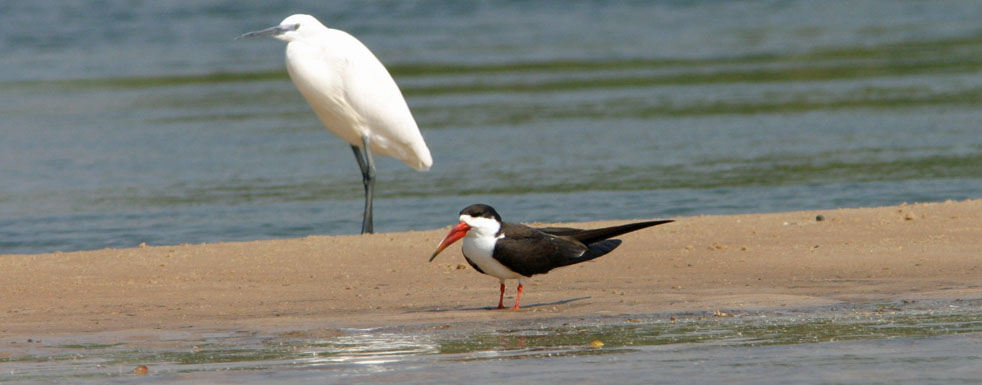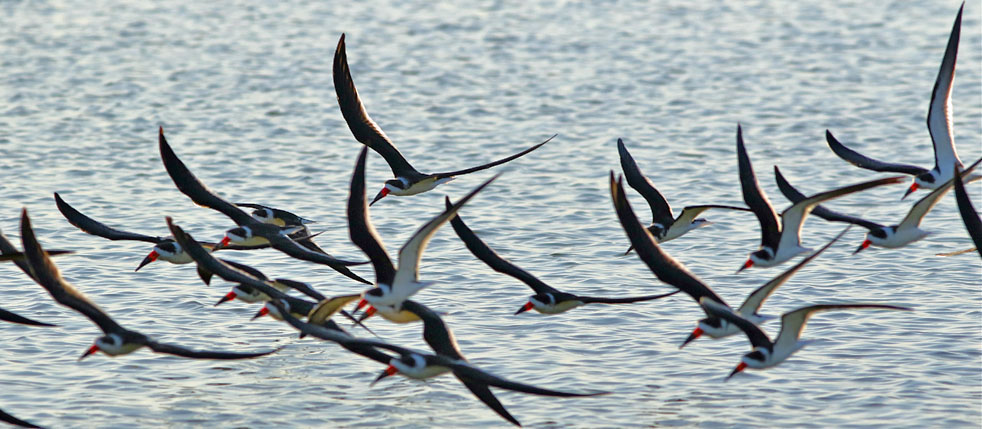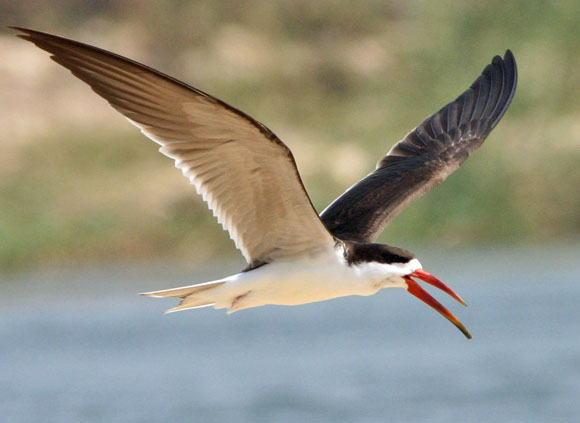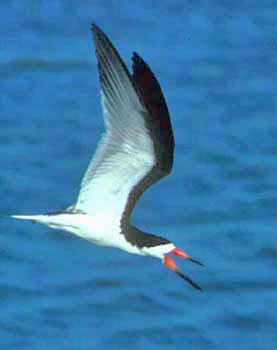
a web page by Don Roberson |
SKIMMERS Rynchopidae |
|
Skimmers are closely related to gulls and terns; indeed, much recent literature follows Sibley & Monroe (1990) in considering them either a tribe or a subfamily of an expanded Laridae which includes gulls, terns, and skimmers. I prefer the traditional approach that skimmers do constitute a family — a position currently held by some checklists but not by most. It was, however, the approach used in the Handbook of the Birds of the World series (Zusi 1996). |
 |
 |
Adult skimmers are black above and mostly white below. Juvenile birds, such as this hatch-year Black Skimmer (right, in a digitized slide by John Sorensen), have white tips to the upper wing coverts, scapulars and hind-neck, giving them a scaly look. There are three widely separated species of skimmer. The North and South American species is Black Skimmer; it has a dark bill tip in all plumages and a black hindneck in breeding plumage. It is also a bit larger than Old World species. African Skimmer is quite similar but adults have a more extensive red or red-orange bill, with only a small darkish tip (or yellow in breeding condition). Indian Skimmer Rynchops albicollis is quite like the African bird in bill color but breeding-plumaged adults have a white nuchal collar. Alas, these differences break down in the non-breeding season when all skimmers have white collars around the neck, and young skimmers of any species can have a dusky tip to the bill. Indian Skimmer is classified as "vulnerable" and the total population is only about 10,000 birds (Zusi 1996). It is restricted to the Indian subcontinent with much smaller numbers locally in southeast Asia. |
 |
Skimmers are social birds, typically nesting in colonies and often roosting with gulls and terns, although they may forage alone or in small parties. This photo of Black Skimmers (above) shows part of a large social group that were leaving their roosts in a coastal lagoon in Cuba.
In California, Black Skimmers underwent a significant expansion in the late 20th century. The State's first record was in September 1962 on the southern California coast, but the real incursion began in 1968 with five at the Salton Sea; by 1995, some 487 pairs were nested there. Breeding on the California coast begin in San Diego Bay in 1976 and in Orange County in 1985. The statewide nesting population was estimated at 1200 pairs in 1995 (Collins & Garrett 1996). This Black Skimmer photo (left) documents one of the very first records for San Francisco Bay in July 1978. The first nesting in San Francisco Bay began in 1994 (Layne et al. 1996) and has continued every since. Through the 1990s local observers in Monterey County (where I live) found migrants passing through to the growing S.F. Bay colony. Small numbers continue today, 20 years into the 21st century, as those breeding in San Francisco Bay pass up the coast in spring, and return south (with youngsters) each fall, transiting Monterey County's coast and the Elkhorn Slough estuary enroute. |
Photos: The two photos of African Skimmer Rynchops flavirostris were taken in the Okavango Delta of Botswana on 24 July 2005. The skimming Black Skimmer Rynchops niger was at Moss Landing, Monterey Co., California, on 8 May 202. John Sorensen photographed the juv Black Skimmer at Del Monte Beach, Monterey, California, where it is a rare migrant 27 Sep 2000. The large group of Black Skimmer were at Zapata Swamp, Cuba, on 8 Feb 2017, and one of the first to reach San Francisco Bay was taken from Alvarado, Alameda Co., California, on 20 July 1978. All photos © Don Roberson, except the photo attributed © John Sorensen, and used with permission; all rights reserved. Bibliographic note: There is no family book, although skimmers are included in numerous texts which cover gulls and terns. The account by Zusi (1996) in the Handbook of the Birds of the World series is a good introduction. Among the great photos there is a Kevin T. Karlson shot of a skimmer in full mouth-agape skim, recalling the Truslow photo so talked about in my youth. Literature cited:
|
 The skimmers [Rynchopidae] are a small family of specialized shorebirds found widely in the North & South America, Africa, and in India. The three species are so closely related that some have considered them all one global species, a situation that recalls others closely-related groupings such as oystercatchers or the stilts. All skimmers have a modified bill with the lower mandible extending well beyond the tip of the upper mandible. This feature is easily seen on this African Skimmer in flight (left), or at roost in the Okavango Delta (below; with a Little Egret Egretta garvetta).
The skimmers [Rynchopidae] are a small family of specialized shorebirds found widely in the North & South America, Africa, and in India. The three species are so closely related that some have considered them all one global species, a situation that recalls others closely-related groupings such as oystercatchers or the stilts. All skimmers have a modified bill with the lower mandible extending well beyond the tip of the upper mandible. This feature is easily seen on this African Skimmer in flight (left), or at roost in the Okavango Delta (below; with a Little Egret Egretta garvetta). Skimmers use their unique bills to scythe estuaries, lakes, large rivers and ponds for small fish. Food is caught almost exclusively by skimming the water in flight with mouth open and lower mandible submerged. Prey items touched by the mandible are grasped while head doubles back under body, and then the fish is swallowed in flight or after landing. As a youth, I recall seeing Frederick Kent Truslow's photo which showed a skimmer in full skimming mood and in focus; a technical accomplishment with 1950s equipment. He had done so by focusing on a floating leaf and waiting until the skimmer passed through this same focal plane (Truslow 1970; that photo has been republished in many other books). Now anyone can take a similar shot with a digital camera: this Black Skimmer (above) — the widespread New World species — leaves a wake across Moss Landing harbor a skimming run.
Skimmers use their unique bills to scythe estuaries, lakes, large rivers and ponds for small fish. Food is caught almost exclusively by skimming the water in flight with mouth open and lower mandible submerged. Prey items touched by the mandible are grasped while head doubles back under body, and then the fish is swallowed in flight or after landing. As a youth, I recall seeing Frederick Kent Truslow's photo which showed a skimmer in full skimming mood and in focus; a technical accomplishment with 1950s equipment. He had done so by focusing on a floating leaf and waiting until the skimmer passed through this same focal plane (Truslow 1970; that photo has been republished in many other books). Now anyone can take a similar shot with a digital camera: this Black Skimmer (above) — the widespread New World species — leaves a wake across Moss Landing harbor a skimming run. African and Indian Skimmers, and most Black Skimmer in South America, are primarily denizens of large rivers. North American skimmers are unique in their dependence of sandy coasts and barrier islands. They tend to be much scarcer inland, although they now nest at the Salton Sea in the California deserts.
African and Indian Skimmers, and most Black Skimmer in South America, are primarily denizens of large rivers. North American skimmers are unique in their dependence of sandy coasts and barrier islands. They tend to be much scarcer inland, although they now nest at the Salton Sea in the California deserts.